From the laboratory to the war front
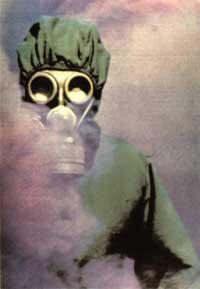
At the end of last March (no concrete date can be given, as different sources give other dates), thousands of wounded people and thousands of people died after suffering terrible suffering. Iraqi aviation used chemical weapons in this Iran-occupied Kurdistan region. During those days other bombs fell to the rural villages of Dojail, Khormal and Anap, in the Halabja area.
Although it is clear that the aggression was by gases, it is not known exactly what gas it was. However, it seems that among others, iperite was the main one. 80% of defenseless people attacked by this gas are suffocated. It also produces ophthalmological alterations, skin burns and lung wounds. On the other hand, it seems that the deceased in a few minutes died from the action of another toxic agent. However, this is a field of doubt.
Abundance of chemical weapons
These events have brought chemical weapons to the first category of today. However, the history of these toxic products has not begun. It began in the war of 1414-1818 and will remain as the first large conflaco in history. In 1915 the wind was heading towards the Russian troops on the Polish front and the German soldiers opened large chlorine cylinders. These products were used by the Germans for the first time in July 1717, in the flamenco sector of Ypres, hence its name to the iperito.
Sixty years later the iperite is the head of the chemical weapons list. As for efficiency, other products have been advanced.
Chemical weapons can usually be classified into two groups: some are lethal agents (intended for the death of the enemy) and other incapacitating agents (which leave individuals out of confusion without dying).
These disabling agents have psychotropic effects (hallucinations, nightmares), irritants (riot gases, often halogenated (the molecule has a chlorine atom or bromine), which affect nerve endings, especially mucosal level. They have a lacrimogenic effect (ethyl bromoacetate, chloroacetophenone, bromoacetone) or are agents of sneezing and/or cough (syringes, chloroartsines) that can contain paralyzers (with provisional effects on the mummy functions and without sequelae), among others.
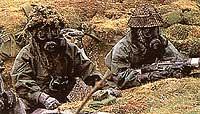
The incapacitators therefore seek to expel or defend the enemy from conflict, causing brain alterations or physical diseases. They have been distributed in physical incapacitants and psychotropes depending on their physical or psychic incidence. Among the psychotropes are mescaline, silocivina, water, chilli derivatives and lysergic acid derivatives (LSD). They are very active in small doses: they alter reasoning, paralyze the will, cause depressive situations or cause hallucinations. Physical incapacitants include apomorphine (causes nausea and vomiting), decametonium (lowers blood pressure), seat (sleep-giving), thera (has effects similar to Parkinson's disease), etc. outstanding.
Iperite or mustard aroma gas
The vesicant iperite spread by Kurdistan is among those who attack the skin creating vesicles or blisters. In 1886 the German chemist Meyer made a communication on the synthesis of a product of great opening effect. This synthesis was obtained from alil sulfide derived from hydrochloric gas (HCl), bis(2-chloroethyl). Although the Germans called LOST attack substance, the English called it gas mustard referring to the smell. However, it has been said that it is currently known as iperite.
This “gas” is actually liquid (boiling point at 215ºC), in the form of oil, which solidifies below 10ºC. It spreads in the form of small drops or clouds and in 1-12 hours after contact with the skin, produces terrible erythema and severe itching. It also produces edema, ulcers and necrosis in both the skin and the airways. People attacked also suffer from strong acute conjunctivitis that can cause coughing and glare. These vesicant elements can even cause death (it is estimated that between 4 and 5 g are enough to kill a medium-sized person).
At the moment there is no effective therapeutic against skin lesions produced by the Iperito. Using a basic solution (bleach) it is only possible to remove excess product, sterilize the wound and relieve pain. The process of opening by Iperita remains unknown. It is believed to affect certain protein groups and therefore protein enzymes and nucleoprotein acids are altered. Consequently, respiratory blockage and paralysis of mitosis (cell division) produce effects similar to those of ionizing radiation.
At best, it takes two or three weeks to heal the wounds, except for those of the eyes that heal very slowly.
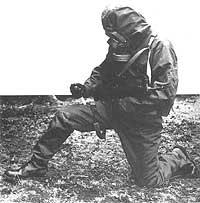
Ingestion of mustard gas or food contaminated by this gas is rarely fatal, causing nausea and vomiting in most cases.
On the other hand, what makes iperite particularly bad is its sustainability. The small amount is very stable in the water; especially when the rainfall is weak (as in the case of Kurdistan), it can be attached to the soil and objects for a dozen years. Decontamination is difficult, since mustard gas particles do not react with water, except in the basic or oxidizing interval (sodium hypochlorite, bleach). Consequently, any area affected by this toxic becomes inaccessible for a long time.
The costume is not enough against the attack of Iperitaje, it is necessary a waterproof suit that covers the whole body. Only some special teams trained for chemical warfare have this support. Therefore, bombing equipped and unwarned civilians with that poison is seeking hekatonbea.
But the iperite is not the only one. Next to it there are other openers such as trichloroethylamine and lewisite. However, both are unused, since the first is not very stable and the second is known as the effective antidote, BAL (British Anti-Lewisite).
Incapacitators therefore have no ability to kill (except by accident or poorly calculated doses). It seems, therefore, that in addition to the iperito, the Iraqis used some other product.
Death Gases
Lethal gases include hemotoxic and neurotoxic. Among the most known hemophotoxins are cyanhydric acid (HCN) and cyanogen chloride (ClCN). These two products are inhibitors of cytochrome oxidase, that is, of the enzyme that transfers oxygen that carry red blood cells to cells. Its effect is fast and total; if there are no antidotes (thiosulfate, sodium nitrite), 60 milligrams are enough to die. The effect of this toxic can be similar to that of carbon oxide (II), which occupies the place of oxygen in hemoglobin. They are especially dangerous when hemotoxic is inhaled. Special costumes are needed to avoid their impact.
However, two products present difficulties of use: hydrocyanic acid is very volatile and it is very difficult to create effective and persistent concentrations. Cyanogen chloride, on the other hand, despite being heavier than air, is easily detectable due to the tear and suffocating effect.
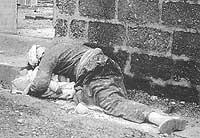
It seems, therefore, that the gases used in Halabja and surrounding areas do not belong to this group. According to experts, once the images are seen, the use of some neurotoxic can be suspected. bila1.937 the German chemist Gerard Schrader discovered the first neurotoxic letatas while researching organophosphate insecticides.
Neurotoxins, therefore, are organophosphorus elements found in most pesticides and insecticides. The best known are the Prize, the Tabun, the Soman and VX. These products act at the neuro-muscular level. They inactivate the enzyme cholinesterase that helps all the impulses of the brain, blocking the nerve impulse. In a few minutes, sensory coordination is lost, salivary secretion is increased, vomiting, cramps, visual alterations and convulsions occur, and death from suffocation can finally occur.
All these neurotoxins are liquids of very low volatility that extend in the form of drops or clouds. They are active both by inhalation and by skin.
Even more poisonous gases
It must be said, on the other hand, that in this field numerous investigations are being carried out, but not so much to find antidotes, but to find products more efficient than the previous ones. This is how the Americans discovered the “VX” agent among the “V” agents, which is 100 times stronger than the previously known award.
Following these investigations, the US found leading binary weapons today. These weapons are made up of two separate products that do not cause any harm. When shooting, shock or explosion creates a kind of cocktail with a frightening poison. From the military point of view the influence of these weapons is double: on the one hand they are much easier to handle and on the other, they prevent knowing the size of the stock of chemical weapons. Since December 16, 1987, the Pentagon’s “binary” program has the green light of the American Congress and NATO allies.
However, the effectiveness of chemical weapons is not measured only by their toxicity and ease of use. From a military perspective it is sought to destroy at the same time the enemy. Therefore, it is necessary to know immediately what chemicals will be attacked after the alert. Detection is therefore of great importance in the face of chemical attack. Thus, in France, for example, the construction of a fully perfected alarm centre (DETADIS détection a distance or remote sensing) is projected for 1991-1992. These devices work on the same principles as radar: instead of emitting and receiving electromagnetic waves, it will emit infrared rays and its different length will inform the military of the nature of air compounds.
Chemical warfare in the hands of anyone
To have chemical weapons, countries don't have to have cutting-edge technology. Chlorine, phosgene or hydrocyanic acid are necessary in the chemical industry as well as in other sectors. Its manufacture does not require complex installations or highly qualified scientific or technical personnel. These products immediately pass from civil to military. The dithioglycol used by the pharmaceutical industry to obtain new drugs, provides iperite by reaction to hydrochloric acid; the dimethylamine used in agrochemicals serves for the manufacture of taboo; potassium fluoride (used in the pharmaceutical and electronic industry or for the manufacture of glass etchings and toothpaste) can also be military; another neurotoxic gas, sarina, can occur.
These “cheap gases”, therefore, have no difficulty producing and are a great help in replacing back rifles with chemical weapons in the military arena.
Mortuary biology
Another part of these laboratory weapons are biological weapons. The world health organization has defined these weapons as: “It is any substance that reproduces in the living organism that attacks it and causes the disease or death of the victim.”
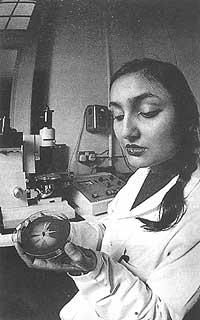
These weapons were mainly formed by bacteria around 1965, which were replaced by viruses five years later. And there is reason for this: due to the advance of genetic engineering, it allows to produce viruses with total security (previously there was risk of contagion) and in addition virus infections weaken the body more than bacterial. Bacterial infections, on the other hand, are cut immediately with antibiotics.
In the viral arsenal, the most remarkable figure is the agent of botulism, whose genetic material is easily constructed through the abundant bacteria Escherichia coli in the intestinal flora.
Some toxins segregated by some animals, plants, or bacteria may also be used. For example, toxins from snake venom simultaneously attack the muscle and neurological system. They are toxins of biological origin but of chemical structure. Therefore, they can be manufactured by chemical procedures and are not reproductive. The toxin offers advantages from the military point of view against other biological microorganisms: Easy production, handling and stock.
It is also necessary to take into account the effectiveness, conservability, or non-rechargeable biological weapons and their proper dissemination. Microorganisms are not the only factor to consider, but the reaction of the host. For example, one individual affected by the flu may get sick and the other may not. Knowing in detail the effects on the population of this fever, margha, pest, typhus or living pathogens of brucellosis is not an easy task or predicting how these virulences of pathogens will evolve over time. It is necessary to know the side effects and the exact durability of the epidemiological transmission of the agent.
In 1.94, the British made an unfortunate experience on the small Scottish island of Gruinard. They were biological warfare sessions and the English army launched thousands of spores from the coal bacillus. It is a bacterium that causes skin, lung, and digestive tract infections and can cause untreated death. But in the experiment they forgot something very important: the weather changes made them great resistances for dozens of years of bacilli. Result: Since 1943 the islet is isolated and must still remain so for years.
It is therefore clear that the difficulties of estimating the use of biological weapons make these weapons even more dangerous.
The arsenal for this pest and disease war is very cheap and very easy to manufacture. In addition, biological aggressions are very difficult to detect, since it is not clear whether it is an attack and a natural pest or epidemic.
As if that were not enough, it is also possible to destroy all the agriculture and the livestock of extensive terrestrial places through well selected pests or diseases. As a result, in addition to diseases, hunger must be addressed.
Modern warfare, therefore, is written with the letter NBK, nuclear, biological and chemical. As we talked more about the first one, here we wanted to give some brushstrokes about the other two.
Buletina
Bidali zure helbide elektronikoa eta jaso asteroko buletina zure sarrera-ontzian











